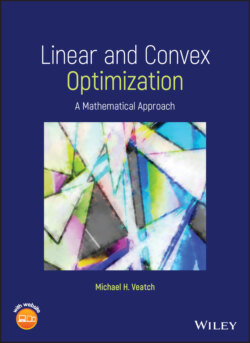Читать книгу Linear and Convex Optimization - Michael H. Veatch - Страница 20
General Form of a Linear Program
ОглавлениеThere are decision variables, and functional constraints. The constraints can use a mixture of “”, “”, and “”. Each variable may have the bound , , or no bound, which we call unrestricted in sign (u.r.s.). The distinguishing characteristics of a linear program are (i) the objective function and all constraints are linear functions and (ii) the variables are continuous, i.e. fractional values are allowed. They are often useful as approximate models even when these assumptions do not fully hold.
We will use matrix notation for linear programs whenever possible. Let , , , and
Here , , and are column vectors. If all the constraints are equalities, they can be written . Similarly, “” constraints can be written .
Example 1.2 Consider the linear program
(1.4)
Converting the objective function and constraints to matrix form, we have
If we let
then this linear program can be written
It is important to distinguish between the structure of an optimization problem and the data that provides a specific numerical example. The structure of (1.4) is a minimization linear program with “” constraints and nonnegative variables; the data are the values in , , and .
To write a mixture of “” and “” constraints, it is convenient to use submatrices
and write, e.g.
